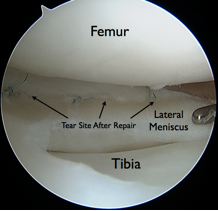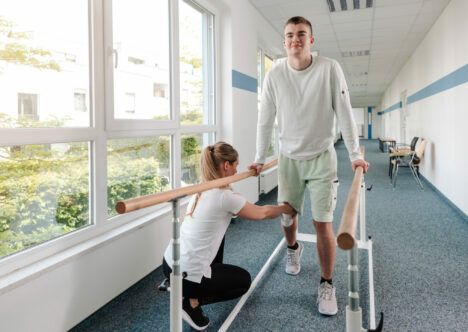Use our convenient online scheduler to book an appointment now.


How is a torn meniscus repaired? Town Center Orthopaedics explains what you need to know.
What Happens During Surgery for a Torn Meniscus?
The meniscus is a rubber-like C-shaped disc that sits within the knee between the end of the thigh bone (femur) and the top of the shin bone (tibia). Meniscus tears usually happen when the knee suddenly twists or pivots. Wear and tear on the knee as we age can also lead to a tear.
When the meniscus tears, the torn pieces irritate the tissue (called the synovium) inside the knee, which causes local pain. The synovium also produces fluid in response to the irritation, but the fluid can’t drain away. Instead, it builds up and increases the pressure in your knee, which increases your pain. Additionally, the loose flaps of the tear may get caught between the two bones of your knee joint. This may cause a popping or catching sensation, particularly with twisting or squatting.
There are two meniscus surgeries available for treating your symptomatic meniscal tear: a meniscectomy or meniscus repair.
Meniscectomy: Many meniscal tears will not heal on their own or if stitched back together (repaired). It may be a severe tear, or the tissue may be degenerative or fragmented into small pieces, unstable, and or have poor blood flow or supply. Any of these will likely prevent the meniscal tear from healing.
In these cases, the only torn meniscus surgery likely to resolve your symptoms is a meniscectomy. Fortunately, most meniscectomys are partial meniscectomys. During a partial meniscectomy, only the small torn pieces of your meniscus are removed. The remaining functioning meniscus is retained.
Meniscectomy: Basics
- It is outpatient surgery (you go home the same day).
- You’ll be under general anesthesia or receive a regional nerve block.
- The surgery takes about half an hour.
- It’s an arthroscopic procedure where thin surgical instruments are inserted through a small incision.
- A small shaver with suction and small scissors are used to remove the torn meniscal pieces.
Watch this torn meniscus surgery video for an arthroscopic view of a partial meniscectomy.
Meniscectomy: Aftercare
- The site will have a soft dressing.
- Use crutches or a cane for comfort or safety as needed for several days.
- You will be allowed to include weight-bearing as able and activities as tolerated.
- Follow physical therapy and or home exercises.
- You should see the expected improvement within one to six weeks.
- You should expect a full recovery within three to four months.
Meniscal Repair: Some tears may heal if stitched together and stabilized. For these tears, the correct torn meniscus surgery is a meniscal repair, usually performed arthroscopically. During the procedures, sutures or small devices that incorporate sutures are used. Larger incisions may occasionally be needed.
Watch the video below to view an arthroscopic meniscal repair.
Although the basics described above for a meniscectomy are essentially the same for a meniscal repair (except for repairing the meniscus rather than removing it), there are differences in the aftercare:
Meniscal Repair: Aftercare
- Limited weight-bearing and the need for crutches may be required to protect the repair.
- A short-term knee brace may be required.
- Jogging is usually delayed for at least three months after surgery.
- Sprinting and agility training are usually restarted between four and five months post-op.
- Anticipated return to all activities is around six months post-op.
Feel Better. Move Better. Be Better.
If you’ve been diagnosed with a meniscal tear and surgery for a torn meniscus is recommended, don’t worry—and don’t hesitate. Talk to an orthopedic surgeon at Town Center Orthopaedics at one of our convenient locations in Ashburn, Centreville, Fairfax, and Reston about your situation. We can help put your mind at ease about the surgery and your recovery. To schedule an appointment, call us at any time at (571) 250-5660 or request an appointment online. We look forward to helping you get back to your active lifestyle soon.
Join our Mailing List
TCO provides patients with orthopedic problems the trusted resources and patient-centered advice they need to “Feel Better. Move Better. Be Better.”
© 2024 Town Center Orthopaedics | All Rights Reserved


